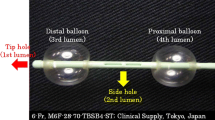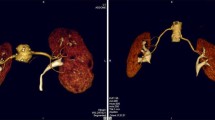Abstract
Purpose: To simulate drug distribution during balloon-occluded arterial chemotherapy infusion (BOAI) for urinary bladder cancer using subtraction computed tomography (CT) with low-flow-rate arterial contrast injection (S-CTLA).
Methods: Ten patients with bladder cancer underwent S-CTLA, and the distribution of contrast agent during BOAI into both internal iliac arteries simultaneously was evaluated in nine pairs of internal iliac arteries and one single artery. For S-CTLA, spiral CT data were acquired before and after 0.2 ml/sec intraarterial injection of contrast material. The enhancement of the urinary bladder wall, the gluteal muscles, and the pelvic bones was categorized using a 4-grade scale. The grades were compared in each of the three pelvic components and differences were tested for significance using the Wilcoxon test for paired groups.
Results: S-CTLA revealed the distribution of the contrast agent clearly. Gluteal muscles grades were significantly higher than those of the other two assessed components.
Conclusion: BOAI does not improve the concentration of contrast agent to the bladder wall over neighboring structures, suggesting that the balloon occlusion technique does not achieve its desired goal for chemotherapy targeting.
Similar content being viewed by others
References
Yamada R, Yamaguchi S, Nakatsuka H, Nakamura K, Sato M, Kobayashi N, Takashima S (1981) Balloon-occluded arterial infusion: A new method for administration of anticancer drugs. Nippon Acta Radiol 41:894–896
Yamashita Y, Takahashi M, Bussaka H, Korogi Y, Saito R, Miyazaki K, Fujisaki S, Okamura H (1989) Balloon-occluded arterial infusion therapy in the treatment of primary and recurrent gynecologic malignancies. Cardiovasc Intervent Radiol 12:188–195
Sawada T, Yoshimura Y, Kawakami S (1994) Balloon-occluded arterial infusion (BOAI): Treatment of patients with locally advanced cervical carcinoma. Anticancer Res 14:2791–2794
Tsuji K, Yamada R, Kawabata M, Mitsuzane K, Sato M, Kwahashi M, Kitayama S, Nakano R (1995) Effect of balloon-occluded arterial infusion of anticancer drugs on the prognosis of cervical cancer treated with radiation therapy. Int J Radiat Oncol Biol Phys 32(5): 1337–1345
Arima K, Tochigi H, Sugimura Y, Kawamura J (1997) Balloon-occluded arterial infusion as a useful neoadjuvant chemotherapy for bladder cancer. Br J Urol 80:417–420
Mori K, Yoshioka H, Nakajima K, Nozawa K, Sugawara S, Itai Y (1998) Usefulness of a new technique to assess drug perfusion pattern on balloon-occluded arterial infusion therapy (BOAI) for intrapelvic malignant neoplasms: Subtraction CT with low-flow-rate arterial injection (S-CTLA). Nippon Acta Radiol 58:38–40
El-Domeiri AA (1976) A method of intermittent occlusion and chemotherapy infusion of the hepatic artery. Surg Gynecol Obstet 143:107–109
Anderson JH. Gianturco C, Wallace S (1981) Experimental transcatheter intraarterial infusion-occlusion chemotherapy. Invest Radiol 16: 496–500
Wile AG, Kar R, Cohen RA, Jakowatz JG, Opfell RW (1987) The pharmacokinetics of cisplatin in experimental regional chemotherapy. Cancer 59:697–700
Kim EE, Bledin AG, Kavanagh J, Haynie TP, Chuang VP (1984) Chemotherapy of cervical carcinoma: Use of Tc-99m-MAA infusion to predict drug distribution. Radiology 150:677–681
Author information
Authors and Affiliations
Rights and permissions
About this article
Cite this article
Mori, K., Yoshioka, H., Nakajima, K. et al. Subtraction CT with low-flow-rate arterial contrast injection to estimate drug distribution during balloon-occluded arterial chemotherapy infusion for bladder cancer. Cardiovasc Intervent Radiol 23, 198–201 (2000). https://doi.org/10.1007/s002700010043
Issue Date:
DOI: https://doi.org/10.1007/s002700010043




